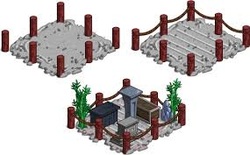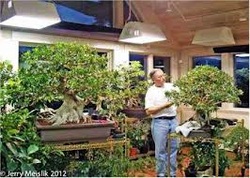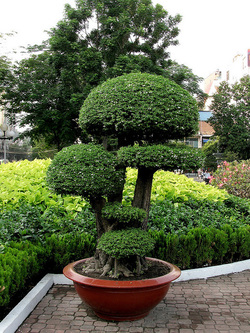
Japan is one of the oldest countries that have several bonsai garden and they have passed the skills to other countries in the world. This type of gardening is more than just an interest, as it requires a commitment. The little trees often need constant care as well as watering. This means that you can never go for a vacation without watering on hope that they will be well when you come back. In addition, they need close maintenance to enable them grow healthy thus enhancing beauty.
The following is a procedure how to make the garden;
1. Pick out the trees as well as containers. Ideally, you have to go to a nursery, which specializes in these Bonsai to purchase your trees. You can also plant your own in a seedling if you have the skills how prepare the seedlings. They seedlings should have shallow pots or even trays that complement the color of tree. You must know that the best colors are often brown, green and gray. You need to sow the plants on the soil prior to adding nutrients and water that are confined together in a container.
2. You have to get your tray or pot ready for the Bonsai plants. Bonsai pots or trays come have numerous holes in their bottom. You can put small pieces of screen over these holes to enable dirt come out right from the bottom. You can use the tags to hold tree ball to place while putting small soil amount in bottom of tray.
3. Repot your Bonsai. Make sure you take your plants away from the pot once you purchase it. You should also remove dirt from the roots before cutting them in a small to fit the new container where you would wish to plant the new seedlings. Make sure that you trim down the roots before putting them into soil to fill the soil up to the top.
4. You also need to take care of the Bonsai. Bonsai tree was not intended to be stored indoors. They like more rainwater and sunshine, although very hard find people putting them outdoors. The plants also need to be watered at least twice a day. In addition, you need to prune them to give them that attractive look if you want to keep them indoors. You should always use concave clippers that will prevent the little stubs from your tree. You may wish to look at books or pictures to get the best idea of how you would probably like your garden to look.
5. You need also to join the Bonsai club to the area. For those people who do not have no specific Bonsai clubs, they may seek people who belong to a garden club has Bonsai. Through this, you will get the best tips as well as answers to most of the questions that people often ask at the beginning. This will also give all information that you might need about this bonsai garden.
In conclusion, the above steps will definitely help you make the best garden.

Bonsai is a Japanese art of growing miniature trees inside low-sided pots or trays. These containers are referred to as bon. Although Japanese culture is the most synonymous with this art, it is widely practiced in China as well.
The Japanese plant the bonsai tree for various purposes: for aesthetic value, for ingenuity in shaping and keeping the plant, for contemplation purposes to those who view it. The bonsai tree is created starting with a specimen source material. Which could either be a seedling, a cutting of a species suitable for bonsai growing, the specimen can be of any perennial wood-stemmed shrub or tree species.
The bush or tree species has to produce true branches which can be cultivated to always remain small through crown and root pruning thus confining it to the pot. Thus it’s the growth of the tree or bush will be confined to the pot environment, it is shaped regularly to limit its growth, also to redistribute its foliar vigor to places requiring more development and also to fit the artistic design of the owner.
Indoor Bonsai:
Bonsai trees typically are trees meant for the temperate climate and do well when grown outdoors. Most die or weaken when cultivated under artificial home environment. However there are some few species which can be successfully grown indoors and do well. Thus they make up a great indoor aesthetic decoration to your home.
Indoor bonsai are taken care of in much the same way as outdoor bonsai are: the basic such as grafting, wiring and pruning work is just the same for the both species. Except the following special adjustment have to be made when placing them indoors:
· Lighting: A room lit comfortably for the human eye is too little to successively growth of these plants indoors. The need over 500 lux of lighting for several hours daily. You either select some of the few species which can flourish under low lights, or you provide extra lighting for them. The simplest way would be placing the tree close to a window.
· Humidity: Most homes especially in the tropics are usually low in humidity. This can be attributed to room heating and air conditioning which reduce the humidity within the house. Only few species like ficus sp. having waxy leave can flourish under such conditions. Majority however can’t and thus you’ll have to provide additional humidification for them to do well.
· Temperature: The standard room temperature is suitable for the growth of bonsai indoors. Since they are tropical trees they tolerate room temperature very well, but they deteriorate under freezing temperature thus leaving them near an open window while its freezing outside can actually damage them.
Best Indoor bonsai tree species:
· Crassula ovata: This is quite robust and drought resistant. For your first bonsai, it is recommended you get this. It has thins roots which can’t be exposed.
· Dracaena marginata: This one can’t tolerate its roots being exposed, it sprouts on old wood and has an amazing dragon-like shape.
· Ficus neriifolia: It is most suited for bonsai species for indoors planting as it develops good branches, incredible basal rootage as well as an amazing aerial root formation.
· Schefflera arboricola: This one is known to be a hardy plant. It can sprout on old wood, thus its older specimen can hence be pruned back to become stockier in shape and it develops thick roots and trunk. It also tolerates root exposure quite well and can survive in moderate lighting.
· Schlumbergera: It is shade tolerant, and it’s known as the Christmas cactus but does not have a real trunk.
· Tamarindus Indica: Frequently used in Taiwan, Philippines and Indonesia, it is increasingly becoming more popular.
These are some of the best species which can survive well indoors. They make your house more beautiful, artistic with a class of elegance and mystery. They are definitely worth having inside your house.



 RSS Feed
RSS Feed